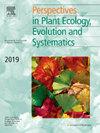Are trait responses of tree species across pyroregions indicative of fire-modulated plant functional strategies?
IF 2.9
3区 环境科学与生态学
Q1 ECOLOGY
Perspectives in Plant Ecology Evolution and Systematics
Pub Date : 2025-03-27
DOI:10.1016/j.ppees.2025.125867
引用次数: 0
Abstract
Fire disturbance is a global eco-evolutionary force affecting plant species persistence and distribution. Pyrogeographic studies so far have identified pyroregions based on their similarity in climate and fire regime parameters. However, which fire-related traits tend to promote or hinder plant species persistence and distribution in different pyroregions remains underexplored. We implement a trait-based approach focusing on 38 tree species in the Mediterranean Basin (Italy), testing whether 1) species distribution across different pyroregions is associated with fire regime, 2) species in different pyroregions exhibit distinct fire-related trait values and, if so, 3) trait differences suggest better abilities to cope with fire and aridity in species distributed in more fire-prone and arid regions (e.g. thicker bark). We ran multivariate analyses (Correspondence Analysis) and linear models (Standardized Major Axis, Ordinary Least Squares) to address our goals. Findings tend to positively answer our questions, emphasizing the importance of including fire-related traits in pyroregionalization studies. Noticeably, the most fire-prone pyroregions collapse into one region from a functional perspective, with species characterized by trait values indicative of adaptations to fire and aridity. A trait-based approach may contribute to refine pyroregionalization exercises while proving useful for management purposes, such as identifying species or life histories whose traits may facilitate their persistence in the face of future, likely exacerbating, fire regimes.
跨火区树种的性状响应是否指示了火调节植物的功能策略?
火灾干扰是影响植物物种持续存在和分布的全球性生态进化力量。迄今为止,火山地理学的研究主要是基于它们在气候和火情参数上的相似性来确定火山区。然而,哪些与火有关的性状倾向于促进或阻碍植物物种在不同焦区持续存在和分布的研究尚不充分。我们对地中海盆地(意大利)的38种树种实施了一种基于性状的方法,测试了1)不同焦区树种分布是否与火灾状况有关,2)不同焦区树种表现出不同的火灾相关性状值,如果是这样,3)性状差异表明,分布在更容易发生火灾和干旱地区的树种(如树皮较厚)应对火灾和干旱的能力更好。我们运行了多变量分析(对应分析)和线性模型(标准化长轴,普通最小二乘)来实现我们的目标。研究结果倾向于积极地回答我们的问题,强调在高温区划研究中包括与火相关的特征的重要性。值得注意的是,从功能角度来看,最容易发生火灾的焦区会坍塌成一个区域,物种的特征值表明它们适应火灾和干旱。基于特征的方法可能有助于改进高温区域化工作,同时证明对管理目的是有用的,例如确定物种或生活史,其特征可能有助于它们在面对未来可能加剧的火灾制度时保持持久性。
本文章由计算机程序翻译,如有差异,请以英文原文为准。
求助全文
约1分钟内获得全文
求助全文
来源期刊
CiteScore
6.50
自引率
0.00%
发文量
28
审稿时长
67 days
期刊介绍:
Perspectives in Plant Ecology, Evolution and Systematics (PPEES) publishes outstanding and thought-provoking articles of general interest to an international readership in the fields of plant ecology, evolution and systematics. Of particular interest are longer, in-depth articles that provide a broad understanding of key topics in the field. There are six issues per year.
The following types of article will be considered:
Full length reviews
Essay reviews
Longer research articles
Meta-analyses
Foundational methodological or empirical papers from large consortia or long-term ecological research sites (LTER).

 求助内容:
求助内容: 应助结果提醒方式:
应助结果提醒方式:


